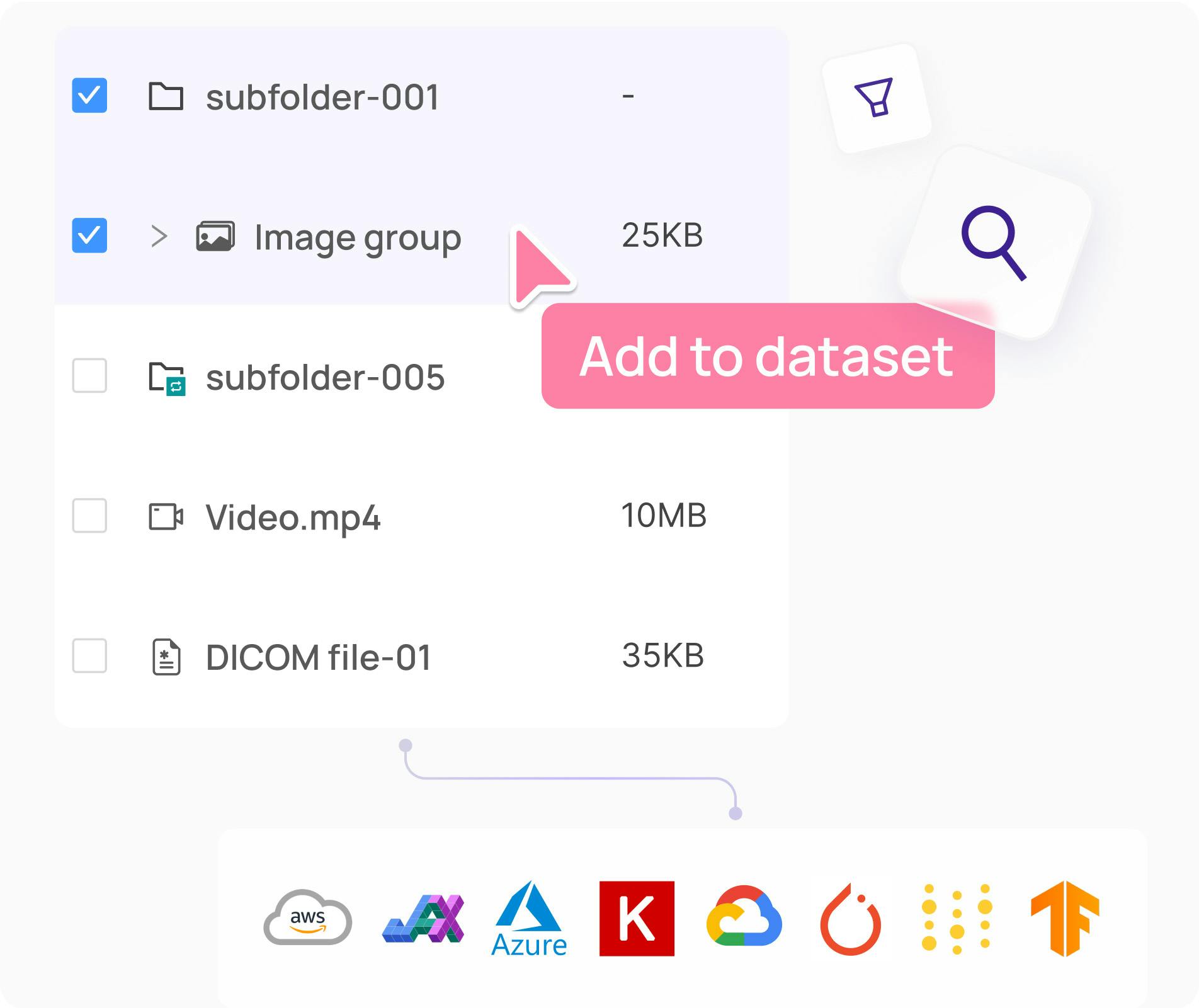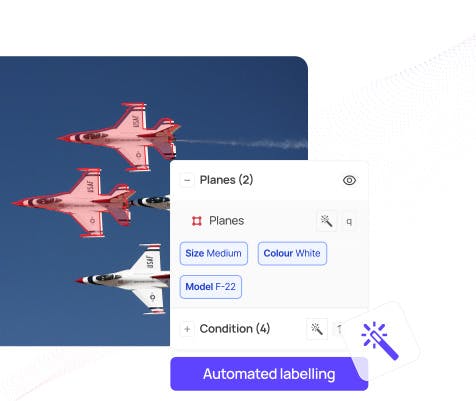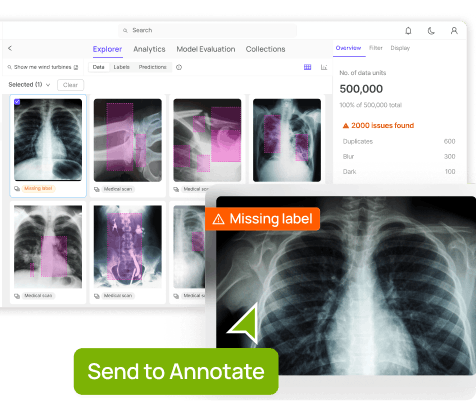Contents
Why Use LLMs to Judge other LLMs?
How LLM-as-a-Judge Works
Types of LLM Evaluation Metrics
Improving LLMs as Judge Performance
AI Alignment and Its Importance in LLM-as-Judge
Challenges of LLM-as-a-Judge
Encord's Approach for Enhancing Text Data Quality for LLM
LLM as a Judge: Key Takeaways
Encord Blog
What is LLM as a Judge? How to Use LLMs for Evaluation
5 min read
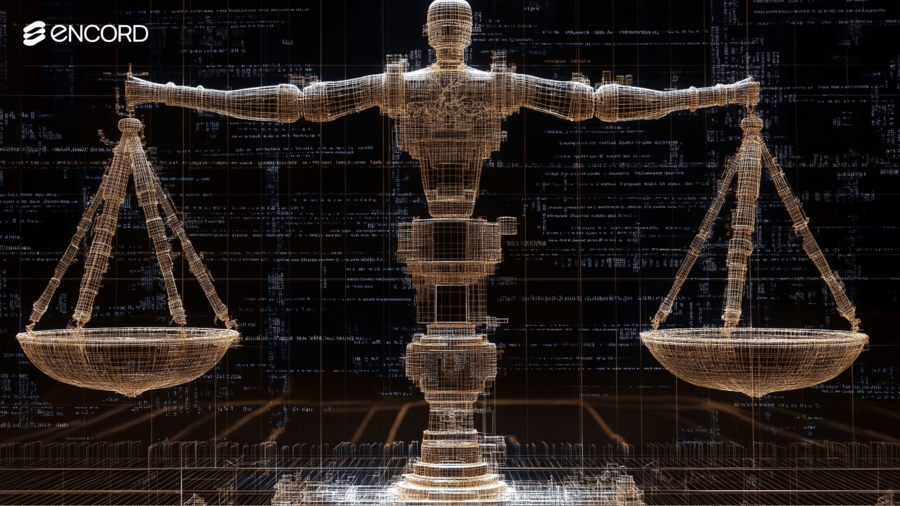
Generative AI (Gen AI) is revolutionizing how we interact with computers today. A recent McKinsey survey reports that over 65% of organizations use Gen AI tools to optimize operations.
Large Language Models (LLMs) are the backbone of such Gen AI solutions as they allow machines to produce human-quality text, translate languages, and create different types of content. However, evaluating the outputs of LLMs can be challenging, especially when it comes to ensuring coherence, relevance, and accuracy. This is where the concept of LLM-as-a-judge emerges.
The LLM-as-a-judge framework addresses these challenges by using one LLM to evaluate the output of another - AI scrutinizing AI. One study suggests LLM judgments match about 80% of human evaluations, indicating that two LLMs agree on judgments at the same rate as human experts. The research concludes that LLM-as-a-judge is a scalable, explainable method compared to hiring human judges..
In this post, we will discuss why LLM-as-a-judge can be valuable in augmenting human reviews, how to use LLMs for evaluation, and how Encord can improve text data quality for LLM. We will also discuss the importance of AI alignment and strategies to improve LLM-based evaluation performance, particularly in the context of chatbot development, large-scale deployments, and real-time decision-making.
Why Use LLMs to Judge other LLMs?
LLMs can help assess the performance of other LLM systems at greater scale and speed than people with near similar accuracy. When judging LLMs with only human reviewers, there are several factors that can cause failures in the process specifically associated with changing behavior resulting from:
- Prompt modifications
- Input method adjustments
- Adjusting LLM API request parameters
- Model switching (e.g., from GPT-3 to Llama or Claude)
- Changes to training data
With so many variables, manually checking for improvements or regressions each time a change occurs is simply not feasible. LLM-as-a-Judge (LaaJ) augments the human review aspect by introducing automation to the process of inspecting and judging while still allowing human-in-the-loop evaluations to occur to meet business or regulatory requirements. The goal of using LaaJ is to verify if the LLM system functions as expected within specified parameters as quickly as possible with some high confidence in accuracy.
This approach evaluates thousands of LLM outputs without significant dependence on human evaluators, saving time and cost. Moreover, LLM judges ensure consistent evaluation criteria and help minimize subjectivity due to multiple human judges. The approach also helps enhance interpretability and observability in the evaluation process of the model.
How LLM-as-a-Judge Works
As a part of the LaaJ process, the model conducting the reviews is evaluating the performance of other models, grading and moderating educational content, and benchmarking AI systems. There are four baseline requirements inorder to set-up LLM judging system which can be classified as DDPA, define, design, present, and analyize:
- Define the judging task
- Design the evaluation prompt
- Present the content for evaluation
- Analyze the LLM and generate judgements evaluating the LLM Judge
Let’s explore each of these in more detail.

LLM-as-a-Judge evaluation pipelines
Define the Judging Task
The first step is to clearly define the task for which the LLM will act as a judge. This includes determining the type of content or output to be evaluated. For instance, the task could be assessing the quality of written responses, determining the accuracy of information, comparing multiple outputs, or rating performance based on certain criteria.
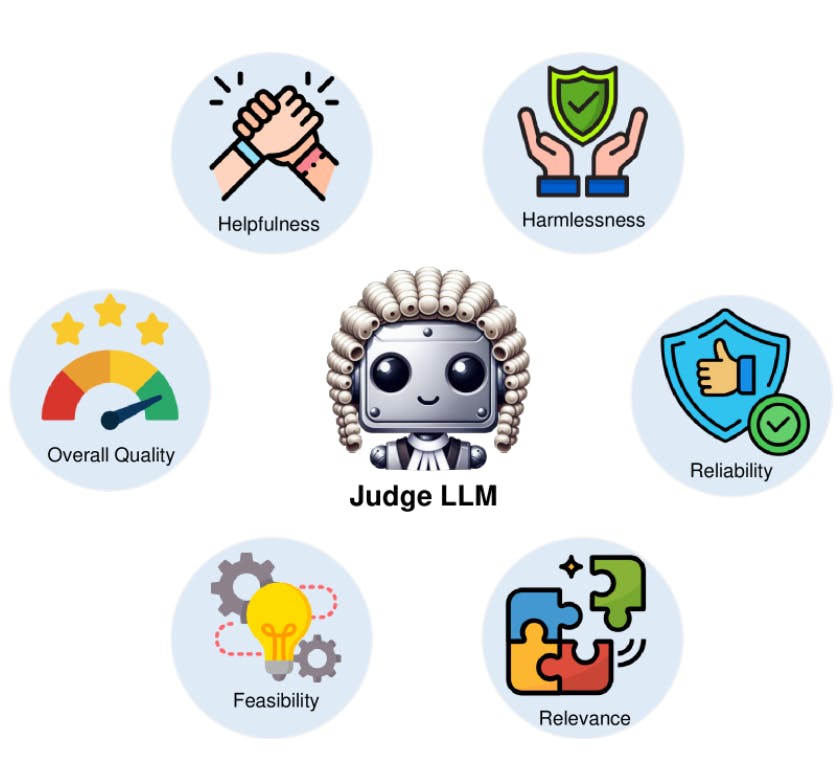
LLMs are capable of judging various attributes
The definition of the task is the foundation for all subsequent steps in the LLM judging process. Here are some examples of task definitions:
- "Judge the following responses based on their clarity, fluency, and coherence."
- "Compare the following two summaries and determine which one best captures the main points of the original article."
- "Rate the following machine translation on a scale of 1 to 5, with 5 being the most accurate and fluent."
Design the Evaluation Prompt
The next step is to design a prompt for the LLM. Effective prompting improves the accuracy of the assessment while reducing bias from creeping in.
What’s are the key components to build a strong evalution prompt?
- The context of the task (the what): Provide background information to help the LLM clearly understand the evaluation scenario.
- Specific criteria for evaluation (the who): Defines specific guidelines for judgment, including rating scales, rubrics, or key qualities such as accuracy, coherence, and tone.
- Instructions on how to format the judgment (the how): Specifies how the LLM should evaluate, whether as a numerical score, a text label, or a more detailed written assessment.
- Necessary background information (the additional context): Any additional context or data, including reference texts or other relevant materials, that may be needed to fully assess the content.
Presenting Content for Evaluation
At this stage, judgement begins.Present the content to be judged by the LLM (e.g., LLM-generated content), this is typically done as part of the prompt and the content can be in various formats, such as text, code snippets, or other types of outputs.
The presentation might include:
- A single piece of content for direct assessment.
- Multiple items for comparison, where the LLM needs to evaluate each separately or in relation to the other.
- Contextual information, such as a reference document when evaluating for hallucinations or other properties that depend on external information.
LLM Analysis and Judgment Generation
Upon receiving the prompt and content, the LLM processes the information using its pre-trained knowledge to analyze the input.
During the analysis, the LLM understands the context, identifies key elements, and applies the evaluation criteria specified in the prompt. This extremely is important as it determines the LLM's comphrension and output of what it was evaluating - in otherwords, it’s assessing the quality of the judge.
Once it analyzes the content, the LLM generates its judgment. This output can take various forms, depending on the instructions in the prompt. For example, it can include:
- A numerical score from 1-10 that reflects the level of quality or performance.
- A qualitative assessment provides a descriptive judgment with added context.
- A comparison between multiple inputs that may involve ranking or selecting a preferred option based on the predefined paramaters
- Detailed feedback or explanations that justify the LLM's evaluation. This is especially important for identifying areas for improvement in the evaluated content and you’re trying to understand how the Judge came to it’s conclusion
Evaluating the LLM Judge
The final step is to validate the evaluation process of the LLM judge and give it a grade. Reminder, a human is invovled through every step of the process so far. This involves comparing the LLM's judgments with human evaluations or other benchmarks, such as a "golden dataset," to measure performance and accuracy. Typically at this stage there are only two possible outcomes: 1/move to production becuase it passed, 2/needs to be modified because it failed.
It’s important to note, there are several different ways to structure the prompt and evaluate LLM-as-a-Judge. There are two core strategies and you should use the best that aligns with your objectives:
- Pairwise Comparison: The LLM is presented with two model responses and asked to determine which is better. This is valuable for comparing different models, prompts, or configurations.
- Single Output Scoring (Pointwise): The LLM evaluates a single response and assigns a score, often using a Likert scale, to assess specific qualities like tone, clarity, and correctness.
You can also combine these techniques with the chain of thought (CoT) prompting to improve scoring quality.
Types of LLM Evaluation Metrics
Relevant LLM evaluation metrics are necessary to assess the performance and quality of LLMs in various tasks. These metrics help determine how well an LLM aligns with intended objectives, ethical standards, and safety requirements.
Common LLM evaluation metrics include:
- Relevance: Evaluate if the LLM's response relates to the given query and whether it addresses the user's question. Relevance is often assessed using human evaluation or automated metrics like BLEU, BERTScore, or cosine similarity.
- Hallucinations: Checks if the LLM's output includes false information not rooted in the provided context or reference text. A hallucination occurs when the LLM generates answers based on assumptions not found in the reference text. By fine-tuning models and using evaluation datasets, developers can reduce the occurrence of hallucinations.
- Question-Answering Accuracy: Assesses how well the LLM can answer domain-specific questions correctly and accurately. This metric compares the LLM's response to a ground truth or reference answer. An LLM judge can evaluate the answer by comparing it to the reference answer to ensure that the response conveys the same meaning.
LLMs Metrics for Retrieval-Augmented Generation (RAG) Application Evaluations
These metrics are specifically used when evaluating Retrieval-Augmented Generation (RAG) systems. The RAG model retrieves information before generating a response. Common RAG evaluation metrics are:
Contextual Relevance
Relevance assesses how closely retrieved documents match the original query. Maintaining contextual relevance is crucial for quick response time and high accuracy. An LLM judge can evaluate this by checking if the reference text contains the information needed to answer the question.
Faithfulness
Faithfulness, known as groundedness, is a metric that assesses how well the LLM's response aligns with the retrieved context. It checks that the answer relies on the retrieved context to prevent hallucinations.
Improving LLMs as Judge Performance
Engineering practices can help improve the performance of LLMs as judges prompt. You can employ Chain-of-Thought (CoT) prompting.
It involves prompting the LLM to articulate its reasoning process, improving explainability and accuracy.
Providing clear instructions in the prompt to the LLM judge is crucial for effective evaluations. Instructions should specify the task context, evaluation criteria, and judgment format.
There are different approaches to implementing CoT prompting. Two of them include:
- Zero-Shot CoT: A zero-shot CoT prompt can be implemented by appending a phrase such as "Please write a step-by-step explanation of your score" to the judge’s prompt. Appended prompts let the LLM explain its reasoning.
- Auto-CoT: Auto-CoT takes zero-shot CoT a step further, where the LLM itself generates the steps for evaluation rather than having them explicitly included in the prompt.
Building on these techniques, the G-Eval method also provides a structured evaluation framework for LLM. G-Eval uses auto-CoT prompting to generate evaluation steps from the original criteria, effectively guiding the LLM through a structured evaluation process.
For instance, G-Eval might guide the LLM to evaluate "Factual accuracy," "Coherence," and finally "Fluency" before determining an overall score. This structured approach enhances the consistency and explainability of LLM-based evaluations.
Beyond CoT prompting, other strategies for improving LLM judge performance include:
- Few-shot learning: Provide the LLM with several high-quality evaluation examples to clarify the desired criteria and style. Include sample responses, evaluation rubrics, or short dialogues that demonstrate effectiveness.
- Iterative Refinement: Continuously analyze the performance of the LLM judge and refine the prompts based on its outputs. This iterative process allows for ongoing enhancement in evaluation accuracy and consistency.
- Structured Output Formats: Using formats such as JSON can make the evaluation results easier to analyze, compare, and share.
AI Alignment and Its Importance in LLM-as-Judge
Using LLMs as judges provides a solution to the challenges of human evaluation. However, users must ensure that the LLM’s evaluations align with human preferences. When discussing LLMs as judges, such alignment refers to how closely an LLM's judgments match human evaluations.
In the above section, we discussed how to enhance LLM performance as evaluators. However, without proper alignment, automated evaluation may yield inaccurate assessments.
Here is why AI alignment is critical for LLM-as-Judge:
- Reliability of Evaluations: The primary goal of using LLMs as judges is to create a scalable and cost-effective alternative to human evaluation. However, if an LLM judge's assessments don't align with human evaluations, the results become unreliable and cannot be trusted.
- Understanding Strengths and Weaknesses: By comparing LLM judge evaluations with human evaluations, users can identify any failure cases and areas where the judges struggle.
- Guiding Improvements: Understanding the failure modes and biases of LLMs as judges helps users focus on how to improve them. Research by OpenAI shows that incorporating human feedback via Reinforcement Learning from Human Feedback (RLHF) can improve alignment by up to 30%.
- Validating LLM-as-Judge: Alignment is important for validating the LLM-as-judge approach itself. If LLMs can't reliably mimic human judgment, their usefulness as automatic evaluators is questionable.
AI alignment in LLM-as-judge is not just about matching scores. Instead, it is about ensuring that the LLMs as judges provide reliable evaluations as a proxy for human evaluators, allowing for fair and accurate assessment of LLMs.
Challenges of LLM-as-a-Judge
LLM-as-a-Judge is a handy technique for evaluating AI systems, but it presents several challenges, including:
- Data Quality Concerns: LLMs base their evaluation judgments on patterns in text, not on a deep understanding of real-world contexts. Poor data quality can mislead LLM, resulting in inaccurate scores.
- Data Variety Limitations: LLMs struggle with grading responses to contextual or cultural questions, needing a deep understanding of specific social norms.
- Inconsistency: While generally consistent, LLMs can sometimes provide inconsistent judgments for complex evaluation tasks, particularly for edge cases or when prompts are slightly changed.
- Potential Biases: LLMs may have biases from training data, affecting their judgments related to race, gender, culture, or other sensitive attributes. One type is self-enhancement bias, where LLM judges may favor responses generated by themselves. For example, OpenAI GPT-4 may assign higher scores to its own outputs.
Encord's Approach for Enhancing Text Data Quality for LLM
It's essential to tackle issues like inaccurate scores caused by low-quality or incorrect training data to improve data quality when using LLMs as judges. A solution like Encord can help by simplifying access to relevant raw data and then enhancing the data’s accuracy and reliability.
Poor data quality arises when the training data on which the LLM is trained is not using all the relevant and correctly annotated data. Therefore, using a curation and highly-percise annotation tool is key to ensuring that the LLM can make more accurate judgments that are inline with the desired outcome.
While many open-source text annotation tools are available, they tend to lack the advanced capaiblities necessary to ensure high-quality text data for training LLMs. Easy to use, scalable, and secure tools such as Encord, are a better alternative as they offer more functionality to deal with complex data management tasks.
Encord’s feature rich annotation tool can enhance labeling accuracy and consistency through its powerful AI-assisted labeling workflows with HITL for diverse use cases. Below are a few key features of Encord that can help you with text and document annotation to boost training data quality for LLM judges.
Key Features
- Text Annotation: The Encord annotation tool can help you label large documents and text datasets in different ways. It makes annotation faster and easier through customizable hotkeys, intuitive text highlighting, pagination navigation, and free-form text labels. Encord supports various annotation methods for different use cases, including named entity recognition (NER), sentiment analysis, text classification, translation, and summarization. This variety allows accurate labeling of text data, which is important for training powerful LLMs.
- Encord RLHF: Encord’s RLHF platform enables the optimization of LLMs through human feedback. This process helps to ensure that model outputs are aligned with human preferences by incorporating human input into the reward function.
- Model-Assisted Annotation: Encord integrates advanced models such as GPT-4o and Gemini Pro 1.5 into data workflows to automate and accelerate the annotation process. This integration enhances the quality and consistency of annotations by enabling auto-labeling or pre-classification of text content, thereby reducing manual effort.
- Collaborative Features: Encord facilitates team collaboration by providing customizable workflows that allow distributed teams to work on data annotation, enhancing efficiency.
- Data Security: Encord complies with key regulations such as GDPR, SOC 2 Type 1, AICPA SOC, and HIPAA. It employs advanced encryption protocols for data privacy compliance.
LLM as a Judge: Key Takeaways
The concept of LLM-as-a-Judge is a transformative to augment the traditional human review process to evaluating LLMs. It offers scalability, consistency, and cost-efficiency, while still ensuring human engagement remains to the level your business requires. Below are some key points to remember when using LaaJ:
- Best Use Cases for LLM-as-a-Judge: LaaJ is highly effective for grading educational content, moderating text, benchmarking AI systems, and evaluating RAG applications. It excels in assessing relevance, faithfulness, and question-answering accuracy.
- LLM-as-a-Judge Challenges: LaaJ can face challenges such as data quality concerns, inconsistency in complex evaluations, and potential biases inherited from training data. Addressing these issues is critical for reliable and fair judgments.
Encord for LLM-as-a-Judge: Encord’s advanced tools, including text annotation, RLHF, and model-assisted labeling, enhance the quality of training data for LLMs. These features ensure better alignment with human preferences and improve the accuracy of LLM judges.
Explore the platform
Data infrastructure for multimodal AI
Explore product
Explore our products
- Define the task, design the evaluation prompt, present content, and analyze the LLM's judgment to automate evaluations like scoring or feedback.
- LLM-as-a-judge comparison involves using one LLM to evaluate and compare multiple outputs, such as ranking responses or selecting the best one. It’s often done through pairwise comparison or single-output scoring.
- LLM-as-a-Judge is an effective method for assessing various subjectively graded tasks, such as the performance of AI systems in text summarization.
- Key metrics include relevance, faithfulness, question-answering accuracy, and hallucination detection.
- Yes, LLMs can moderate content by evaluating text for appropriateness, but require alignment with human standards for accuracy.
